The liver is known for its ability to regenerate. It can completely regrow itself even after two-thirds of its mass has been surgically removed. But damage from medications, alcohol abuse or obesity can eventually cause the liver to fail. Currently, the only effective treatment for end-stage liver disease is transplantation.
However, there is a dearth of organs available for transplantation. Patients may have to wait from 30 days to over five years to receive a liver for transplant in the U.S. Of the over 11,600 patients on the waiting list to receive a liver transplant in 2021, only a little over 9,200 received one.
But what if, instead of liver transplantation, there were a drug that could help the liver regenerate itself?
I am the founding director of the Pittsburgh Liver Research Center and run a lab studying liver regeneration and cancer. In our recently published research, my team and I found that activating a particular protein with a new medication can help accelerate regeneration and repair after severe liver injury or partial surgical removal in mice.
While the liver can regenerate itself, it can’t be endlessly donated for transplants.
Key players in liver regeneration
The liver performs over 500 key functions in your body, including producing proteins that carry fat through the body, converting excess glucose into glycogen for storage and breaking down toxins like ammonia, among others.
Liver cells, or hepatocytes, take on these many tasks by a divide-and-conquer strategy, also called zonation. This separates the liver into three zones with different tasks, and cells are directed to perform specialized functions by turning on specific genes active in each zone. However, exactly what controls the expression of these genes has been poorly understood.
Over the past two decades, my team and other labs have identified one group of 19 proteins called Wnts that play an important role in controlling liver function and regeneration. While researchers know that Wnt proteins help activate the repair process in damaged liver cells, which ones actually control zonation and regeneration, as well as their exact location in the liver, have been a mystery.
Liver disease progresses in four stages.
To identify these proteins and where they came from, my team and I used a new technology called molecular cartography to identify how strongly and where 100 liver function genes are active. We found that only two of 19 Wnt genes, Wnt2 and Wnt9b, were functionally present in the liver. We also found that Wnt2 and Wnt9b were located in the endothelial cells lining the blood vessels in zone 3 of the liver, an area that plays a role in a number of metabolic functions.
To our surprise, eliminating these two Wnt genes resulted in all liver cells expressing only genes typically limited to zone 1, significantly…



